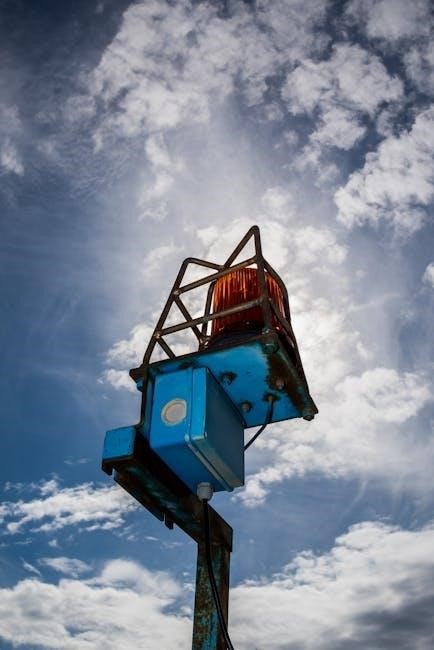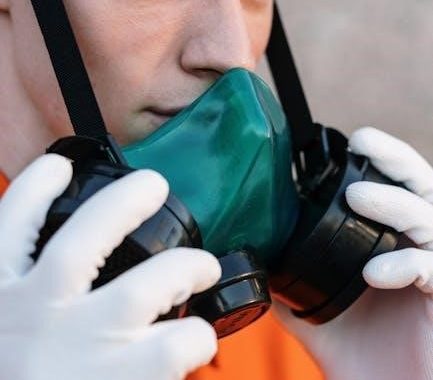The First Alert CO Alarm is a reliable, battery-operated device designed to detect dangerous carbon monoxide levels. It features a silence option for temporary quiet and wireless interconnectivity, ensuring comprehensive home safety with ease of use.
1.1 Overview of the First Alert CO400 Model
The First Alert CO400 is a battery-operated carbon monoxide alarm with a silence feature, designed for easy use and reliability. It includes an 85 dB horn and a red LED indicator for alerts. The alarm detects CO levels and sounds when dangerous concentrations are present, ensuring home safety with minimal maintenance and user-friendly operation.
1.2 Importance of Carbon Monoxide Detectors
Carbon monoxide detectors are crucial for protecting lives, as CO is an odorless, invisible gas that can be deadly without warning. These detectors act as early warning systems, alerting occupants to dangerous CO levels before symptoms arise, providing time to evacuate and seek fresh air, thus preventing potential poisoning and ensuring home safety.

Key Features of the First Alert CO Alarm
The First Alert CO Alarm features a battery-operated design, silence option, and wireless interconnectivity. It includes an 85 dB horn, test/silence button, and LED indicators for alerts and low battery warnings.
2.1 Battery-Operated Design
The First Alert CO Alarm operates on two standard AA batteries, providing continuous protection without hardwiring. It features a low battery warning with a red LED flash and a chirp sound. Replace batteries promptly to maintain functionality. The alarm is designed for easy battery access, and using Energizer E91 batteries is recommended for optimal performance. Battery removal disables the alarm;
2.2 Silence Feature for Temporary Quiet
The silence feature allows temporary quieting of the alarm horn during non-emergency situations, such as low battery warnings or false alarms. Press and hold the Test/Silence button to activate this feature, which lasts up to 4 minutes. After this period, the alarm reassesses CO levels and resumes if dangerous conditions persist, ensuring safety while minimizing unnecessary disruptions.
2.3 Wireless Interconnectivity Options
The First Alert CO Alarm offers wireless interconnectivity, allowing multiple units to communicate seamlessly. When one alarm detects CO, all connected alarms sound, ensuring comprehensive coverage. This feature enhances safety and convenience, eliminating the need for complex wiring. It is compatible with First Alert’s ONELINK Technology, enabling a network of interconnected alarms to protect your entire home effectively.

Installation and Placement Guidelines
Install CO alarms centrally outside sleeping areas and on every home level. Use tools like drills and screwdrivers for secure mounting. Ensure proper placement for optimal detection and safety.
3.1 Recommended Locations for CO Alarms
Install CO alarms centrally outside each sleeping area and on every level of your home; For hallways over 40 feet, place alarms at both ends. Avoid areas near vents or fuel-burning appliances. Follow NFPA recommendations for optimal protection, ensuring alarms are within hearing range and not obstructed by doors or walls.
3.2 Step-by-Step Installation Process
Begin by selecting a location following NFPA guidelines. Use a pencil to mark the wall for drilling. Drill holes using a 3/16 or 5mm bit, then secure the mounting bracket with screws. Attach the alarm to the bracket and test it. Ensure all units are interconnected for whole-home coverage. Replace batteries annually and test functionality monthly for optimal safety.
Understanding Alarm Signals and Indicators
The First Alert CO Alarm uses LED flashes and horn patterns to signal CO detection, low battery, or malfunctions. Understanding these indicators ensures timely and appropriate responses to potential threats.
4.1 Decoding LED Flashes and Horn Patterns
The First Alert CO Alarm signals through LED flashes and horn patterns. Four beeps indicate CO detection, while three chirps signal a malfunction. A red LED flash accompanies alarms, and low battery warnings include a chirp and red flash. Understanding these patterns helps identify the alarm’s status and necessary actions, ensuring safety and proper device maintenance. Always refer to the manual for detailed explanations.
4.2 Low Battery Warnings and Malfunction Signals
The First Alert CO Alarm alerts users to low batteries with a red LED flash and a single chirp every minute. This warning lasts up to 30 days, but batteries should be replaced promptly. A malfunction is indicated by three quick chirps and a red LED flash, signaling the alarm needs replacement. Always address these signals to maintain device functionality and safety.

Testing and Maintenance
Regular testing ensures the CO Alarm functions correctly. Press the Test/Silence button to activate the horn and LED. Maintain by cleaning the alarm and replacing batteries promptly to ensure reliability and safety.
5.1 How to Test the CO Alarm Properly
Press and hold the Test/Silence button until the LED flashes and the horn beeps in a 4-beep pattern. This ensures the alarm is functioning correctly. If it fails to beep, check battery installation and replace if necessary. Regular testing helps ensure the alarm detects CO accurately, providing reliable protection for your home and family.
5.2 Regular Maintenance Tips
Replace batteries annually with Energizer E91 or equivalent. Clean the alarm with a soft cloth to avoid dust buildup. Avoid exposure to chemicals or paint, as they may damage sensors. Ensure no obstructions block the sensor. Regularly test the alarm to confirm proper function. Maintain a clean environment around the device to ensure accurate CO detection and reliable performance.
Troubleshooting Common Issues
Address beeping by checking for low batteries or CO presence. Ensure proper installation and avoid chemical exposure. Replace units failing self-tests immediately for safety and reliability.
6.1 Why Your CO Alarm Might Be Beeping
Your CO Alarm beeps due to low batteries, detected CO levels, or malfunctions. Check LED patterns: red flashes indicate CO presence, while chirps signal low battery. Ensure fresh air and battery replacement. If issues persist, replace the unit immediately to maintain safety and reliability.
6.2 Resolving False Alarms and Error Conditions
To resolve false alarms, ensure the area is well-ventilated and check for potential CO sources. Use the Test/Silence button to temporarily quiet the alarm for investigation. If the alarm restarts, it indicates persistent CO levels. Address the issue promptly, and if unresolved, replace the alarm. Regular testing ensures proper function and reliability.
Understanding Carbon Monoxide Risks
Carbon monoxide is a deadly, odorless gas produced by incomplete combustion of fuels. Common sources include faulty appliances and poor ventilation, posing severe health risks if undetected.
7.1 Sources of Carbon Monoxide in the Home
Carbon monoxide in homes often comes from faulty fuel-burning appliances like furnaces, water heaters, and stoves. Idling cars in attached garages and poorly ventilated fireplaces or wood-burning stoves also contribute. Proper maintenance and ventilation are essential to prevent dangerous CO levels, which can lead to serious health issues if left unchecked.
7.2 Symptoms of CO Poisoning
Symptoms of CO poisoning vary by exposure level. Mild exposure causes headache, nausea, and fatigue, while medium exposure leads to dizziness and confusion. Severe cases result in unconsciousness, seizures, or even death. Vulnerable groups, like infants and those with heart conditions, may experience symptoms more rapidly. Recognizing these signs is crucial for prompt action to prevent serious harm or fatalities.

Safety Precautions and Emergency Response
When the CO alarm sounds, move to fresh air immediately. Open windows and ventilate the area. Do not ignore the alarm, as it indicates potential danger.
8.1 What to Do When the Alarm Sounds
When the CO alarm sounds, immediately move everyone to fresh air outside or near an open window. Do not disconnect batteries or disable the alarm. Evacuate the premises and contact emergency services. Ensure the area is well-ventilated and avoid re-entry until a qualified technician confirms it is safe. Prompt action is crucial to prevent potential harm from carbon monoxide exposure.
8.2 Preventing CO Buildup in Your Home
Prevent CO buildup by ensuring proper ventilation and maintaining fuel-burning appliances like furnaces and water heaters. Never use generators or grills indoors, and keep chimneys and vents clear of blockages. Regular inspections by a qualified technician can help identify potential issues before they become dangerous.

Replacement and End-of-Life Indicators
Your First Alert CO Alarm signals its end-of-life with a red light flashing and three quick chirps every minute. Replace it immediately to ensure continuous protection.
9.1 Knowing When to Replace Your CO Alarm
Your First Alert CO Alarm signals replacement needs with a red light flashing and three quick chirps every minute. This indicates the sensor has reached its end-of-life. Do not ignore this signal, as the alarm’s ability to detect CO will diminish over time. Replace the unit promptly to ensure continuous protection against carbon monoxide threats.
9.2 Proper Disposal of Old Alarms
When replacing your CO Alarm, remove the batteries and dispose of them according to local regulations. Do not incinerate the unit. Check with your community for electronic waste recycling options. Proper disposal ensures environmental safety and adheres to local guidelines, helping to minimize waste and prevent potential harm from hazardous materials.
The First Alert CO Alarm is a crucial safety device for early CO detection. Regular testing, maintenance, and timely replacement ensure optimal performance. Remember to replace batteries annually for uninterrupted protection.
10.1 Summary of Key Takeaways
The First Alert CO Alarm is a vital safety device offering reliable carbon monoxide detection. Key features include battery operation, a silence function, and wireless connectivity. Proper installation, regular testing, and maintenance are essential for optimal performance. Understanding alarm signals, replacing batteries annually, and knowing when to replace the unit ensures continuous protection. Always prioritize CO safety to avoid potential health risks.
10.2 Staying Safe with Reliable CO Detection
Reliable CO detection is crucial for home safety. Proper installation, regular testing, and understanding alarm signals ensure optimal performance. Utilize the silence feature wisely but never ignore persistent alerts. Always have an emergency plan and fresh air sources ready. Stay vigilant to protect your household from carbon monoxide threats effectively.
